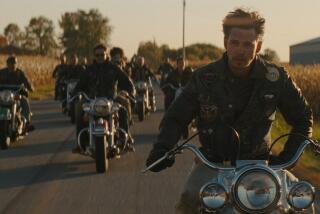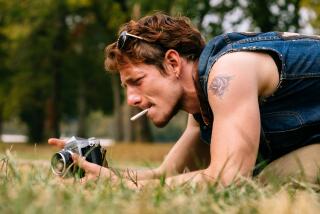A veteran biker has advice on becoming one
Jay Barbieri is the producer of “American Thunder,” the longest-running motorcycle magazine show on television. He’s also author of “Biker’s Handbook: Becoming Part of the Motorcycle Culture,” a new insider’s guide for riders of American motorcycles so they don’t become “that guy.” What does he mean? Read on.
Q: Who is “that guy” in your book?
A: The guy who buys the leather jacket with a huge logo on the back. The guy who buys the pseudo-Nazi helmet with a big spike. The guy who rides up next to the minivan that says “Baby on Board” and revs his bike looking all bad trying to scare everyone inside.
Q: Does that mean this book is for rich urban bikers, or RUBs?
A: It’s not really for RUBs. It’s for three different categories. A guy who went out and bought a bike and isn’t quite sure what to do now that he’s got it; it’s all the things he wants to know but is too afraid to ask. It’s for guys who are new riders. And it’s for guys who’ve been on the road forever to have a laugh and say, “I remember when I got into this.”
Q: You’ve been riding 27 years. Why would you want to give a RUB insider information?
A: Because they have bikes and they’re not going away.
Q: What makes a biker real?
A: Knowledge. Knowing what you’re getting into and what you’re doing and kind of enjoying the road for what it is and the culture for what it is and not trying to be Billy Bad Ass all the time. It’s not about your image. It’s about going to an event, and riding in the rain, and having a good time, and enjoying that same camaraderie with other guys on the road. It’s the best T-shirt ever: If I had to explain, you wouldn’t understand.
Q: What’s the most important lesson in “Biker’s Handbook”?
A: For the new rider: Don’t buy a Harley as a first bike. Go buy a piece of crap out of the Recycler. Ride it in the rain. Fall down on it. Fix it. Learn that bike until you feel ridiculous on it. Then you’re probably doing it right.
Q: I have to say, I was surprised to read a Harley guy advocating protective gear.
A: I grew up with a helmet law in Connecticut. I’ve ridden without a helmet a lot. I still ride in Sturgis without a helmet. Is it smart? Nope. You have to make your own decision. I do believe the right thing to do is wear a helmet as much as possible. I think you should wear a leather jacket if you’re on the freeway. I think getting on a bike and drinking is a bad idea. It’s common sense. I don’t want to see anyone get hurt or hurt me. Plus, guys get a real attitude. Give a guy a new Harley, a leather jacket and a few beers, and it’s testosterone city.
Q: Why did you want to write this book?
A: Over the last five years, the motorcycle culture sort of got blurred. TV shows like “Motorcycle Mania” kind of wiped out the whole stigma of the bad outlaw biker. There was this beautifully produced show on the Discovery Channel, and Mom and Dad and all the kids were sitting around watching this guy on a chopper doing his thing. You put that together with a huge influx of inheritance money to baby boomers, and that culture got wiped out.
Guys a little older than me or my age, when we were kids, our parents were like, “You’re never going to ride one of those Harleys.” And the minute they said that, you’re fascinated by it. What happened was that culture had its own thing, its own stigma. And then you get this huge influx of guys buying these big choppers for crazy money. They’re buying a leather jacket, not shaving and thinking they’ve immediately become bikers. So as a producer and seeing this happen and watching the industry grow, I wanted to set the record straight in my own opinion and just put a little bit of spin on where this came from and why it is the way it is.
Q: Where did it come from, and why is it the way it is?
A: I think it’s really important if you’re going to be part of the motorcycle culture in the U.S. that you know a little about where it was born and bred and sort of the ways of the road, because it started here. Harley-Davidson sold their tool and die to Japan in 1937, and that started the Japanese market, so Harley was really one of the very first companies to have the wherewithal to make motorcycling happen. We borrow so many things from other cultures, this was really authentic. I thought I could address that situation and the RUBs and write about it. These guys are already on the road. Instead of bitching and moaning about it like a lot of hard-core bikers do, maybe we should give those guys a heads-up so they don’t water it down or aren’t so dangerous on the road.
Q: “Biker’s Handbook” is sort of a misnomer. It isn’t for all bikers, but riders who buy American. Why is that?
A: The original title was “Becoming Part of the American Motorcycle Culture.” My publisher didn’t want the word “American” in there because the books they put out with “American” in the title didn’t do well, but this book is about becoming part of the American motorcycle culture. My point is simply this: In the ‘70s, there was a very clear line drawn in the sand. The Japanese said, “We do not want the negative stigma of being outlaw bikes.” The American motorcycle never changed its philosophy.
About 10 to 15 years ago, Harleys got really popular again, and metric motorcycles came up with a V 45 motor and started styling themselves after Harley-Davidson with a lower price point. A lot of guys went out and said, “It looks like a Harley, sounds like a Harley, so I’m going to buy it.” You don’t have to buy a Harley to be part of the motorcycle culture, but this is where I get in all kinds of trouble. You’re buying a motorcycle that wants to be like something else.






